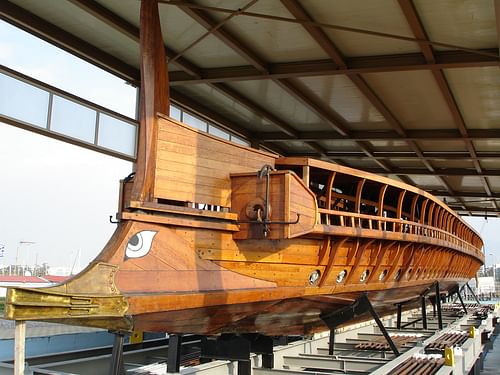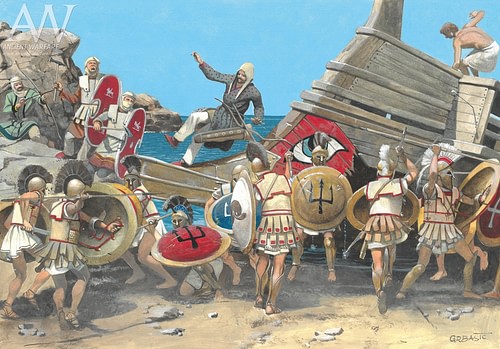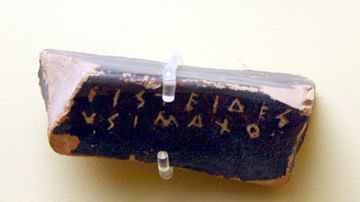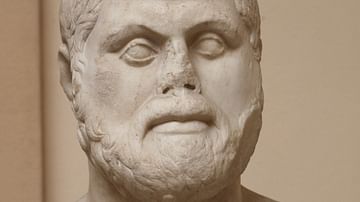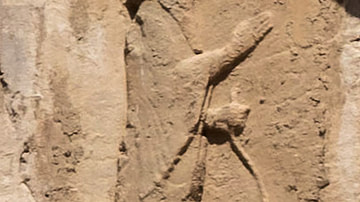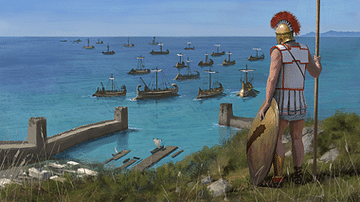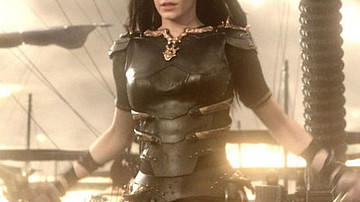
The Battle of Salamis was a naval battle between Greek and Persian forces in the Saronic Gulf, Greece in September 480 BCE. The Greeks had recently lost the Battle of Thermopylae and drawn the naval Battle at Artemision, both in August 480 BCE, as King Xerxes I (r. 486-465 BCE) and his Persian army went on the rampage. The Greeks won at Salamis, one of the greatest and most significant military victories in antiquity. Overcoming superior numbers with daring tactics and sheer determination, the allied Greek forces won a freedom which would allow a never-before-seen period of artistic and cultural endeavour which would form the foundations of Western culture for millennia.
Context: The Persian Wars
By the first years of the 5th century BCE, the Persian Achaemenid Empire, under the rule of Darius I (r. 522-486 BCE), was already expanding into mainland Europe and had subjugated Thrace and Macedonia. The next objective was to quell once and for all the collection of potentially troublesome rebel states on the western border of the empire. In 490 BCE Greek forces led by Athens met the Persians at the Battle of Marathon and defeated the invaders. The battle would take on mythical status amongst the Greeks, but in reality it was merely the opening overture of a long war with several other battles making up the principal acts. In 486 BCE Xerxes became king, and he invaded first the Cyclades and then the Greek mainland after victory at Thermopylae in August 480 BCE against a token Greek force. At the indecisive naval battle of Artemision (also in August 480 BCE), the Greeks held off the superior numbers of the Persian fleet but were obliged to regroup at Salamis.
Greece then, lay open to the invaders and Persian forces rampaged through the Greek poleis or city-states, sacking even Athens itself. Some 30 Greek poleis, however, were preparing to fight back and the Battle of Salamis would show Xerxes that Greece, or at least a large chunk of it, was far from being conquered.
The Persian Fleet
The vast Persian Empire stretched from the Danube to Egypt and from Ionia to Bactria, and Xerxes was able to draw on a huge reserve of resources to amass a huge invasion force. Ariabignes, the son of Darius, commanded the Ionian, Carian, Achaimene, and Egyptian fleets. Cybernis, the king of Xanthos, led the Lycian fleet of 50 ships. Artemisia, the tyrant of Halicarnassus, led the Dorian fleet of 30 ships and other known commanders included Prexaspes, Megabazus, and Achaimenes. Technically, the Persians, and especially the Phoenicians, were better seamen, but as the fleet was drawn from all parts of the Empire, the motivation and communication levels were perhaps less than their opponents who all spoke the same language and who were fighting not only for their own survival but that of their families and their way of life.
The exact number of ships in the Persian fleet is not known. Herodotus in his Histories (440-430 BCE) compiles precise lists but these are widely thought to be exaggerated and unreliable. Also, his list is for the Persian fleet which originally sailed to Greek waters and by the time of Salamis, many would have been left to guard ports and supply routes or have been lost in storms (especially at Magnesia) and in the Battle of Artemision a month earlier. Nevertheless, below are his figures for triremes - warships with three banks of oars (note the contributions from conquered or pro-Persian Greek cities):
- Phoenician 300
- Egyptian 200
- Cyprian 150
- Cilician 100
- Ionian 100
- Hellespontine 100
- Carian 70
- Aolian 60
- Lycian 50
- Pamphylian 30
- Dorian 30
- Cyclades 17
An alternative source - the writer of Greek tragedy Aeschylus - does seem to support Herodotus in his Persae (472 BCE) where he states that the Persian fleet had 1,207 ships compared to the Greek force of only 310. Accounting for losses incurred in the manner described above it is estimated that perhaps around 500 triremes faced the Greeks at Salamis but there is no scholarly consensus on even an approximate figure. There would also have been many smaller ships such as penteconters (50 oars) and triaconters (30 oars) but Herodotus' figure of 3000 seems wildly exaggerated.
The Greek Fleet
The allied Greek fleet was commanded by the Spartan Eurybiades, a surprising choice considering it was Athens who was the great naval power and supplied by far the most ships. The two other senior commanders were Themistocles of Athens and Adeimantus of Corinth. In effect, tactics and strategy were decided by a council of 17 commanders from each of the contributing contingents. However, it is Themistocles, the brilliant naval commander, drawing on his 20-year experience and flush from the success of Artemision against far superior numbers, who is widely credited with deciding to hold position at Salamis instead of retreating to the isthmus of Corinth and masterminding the Greek victory.
Herodotus' figures are once again inconsistent, his grand total of 380 triremes making up the Greek fleet is 15 more than the sum of his individual state contributions:
- Athens 200
- Corinth 40
- Aegina 30
- Megara 20
- Sparta 16
- Sicyon 15
- Epidaurus 10
- Eretria 7
- Ambracia 7
- Troezen 5
- Naxos 4
- Hermione 3
- Leucas 3
- Styra 2
- Ceos 2
- Cythnos 1
The figures for some states are suspiciously similar to those given before the Battle of Artemision, implausibly suggesting either they suffered next to no losses in that conflict or a swift replacement of vessels. Aeschylus states a total figure of 310 and Thucydides 400. In summary, we can only say that the Persian fleet seems to have significantly outnumbered the Greek.
The Trireme
Both sides had very similar ships - the triremes (triērēis) - which were 40-50 ton wooden warships up to 40 m long. Light, streamlined, and manoeuvrable, they were powered in battle by 170 oarsmen split in three ranks down each side of the ship. Able to rapidly accelerate, brake, zigzag, and turn 360 degrees in just two ships' lengths, good seamanship could place the vessel to best advantage and employ the principal strategy of naval warfare at that time which was to ram the enemy, making full use of the bronze ram fitted to the prow of the vessel. Triremes also carried a small complement of soldiers, at least ten hoplites and four archers. The Persians generally carried more - 14 combatants and 30 Medes armed with bow, spear, and sword. These extra troops came into their own when at close quarters with the enemy and in the case of boarding an enemy vessel.
Triremes had a weakness in that they could only operate effectively in relatively calm seas with waves less than 1 m high; otherwise, water would enter via the oar-ports and flood the ship. Also, they had to stay close to shore as each night they needed to be beached if the light wood was not to become water-logged, significantly reducing the speed performance of the vessel. In addition, there was very little space on board for provisions and no room to sleep so the crews had no choice but to land each night. Prior to the battle the Greek ships were beached at several bays on the island of Salamis from Cynosoura to Paloukia. Here too were much of the evacuated populace of Athens and Attica. The Persians, meanwhile, were stationed at the Phaleron Bay, less than 10 km away across the Saronic Gulf and close to the captured Piraeus.
Strategies
Commanders led from the front and each would have been on his own ship at the heart of the battle. From there, manoeuvres could be signalled to other ships in the fleet using flags and trumpets. However, once the battle got fully underway, naval conflicts became a case of a single ship against a single opponent rather than precisely coordinated manoeuvres.
Prior to full engagement between the opposing fleets, there were two principal strategies employed by the more able commanders. The first was sailing around the enemy line (periplous) and the second was smashing through gaps in the enemy line and attacking from their rear flank (diekplous). Both were designed to get one's ship in a position to ram the weakest point of the enemy - the side or stern quarter. The objective was to puncture a hole in the enemy vessel or break a sufficient number of their oars to disable the ship. To avoid damaging one's own oars, crews were drilled to withdraw them in a matter of seconds (usually on only one side of the ship whilst the other side maintained the momentum of the vessel). As a defence against these two tactics, an able commander would ensure one of his flanks was closed off by shallows or coastline and ensure his crews were sufficiently drilled to maintain close order. In open water, the ships could be organised in a defensive circle or an arc (more practical with larger fleets) with prows pointing outwards (kyklos).
The Battle
The actual details of the battle are sketchy and often contradictory between ancient sources. Nevertheless, presenting the most commonly agreed upon elements, the first action of the battle was the defection of two Ionian ships to the allied Greek fleet. Themistocles, perhaps sending messages to the pro-Persian Greek state fleets, had hoped for more such defections but no others occurred. One such ship from Tenos informed the Greeks that the Persians were amassing in the straits, blocking in the Greek fleet. The Persians had moved into position overnight, hoping to surprise the enemy, but this strategy was unlikely to be successful considering the short distances involved and the noise made by the rowers. There is also the possibility that Themistocles had sent messages to Xerxes intimating the fragile Greek alliance was breaking up and the fleet was about to retreat.
Probably, the two fleets aligned along an oblique east-west axis with the Persians close to the mainland shore with both fleets having a friendly shore behind them. Indeed, proximity to the opposite mainland shore would have been avoided by the Greek ships due to Xerxes' positioning of a contingent of his archers there. On the western (right) wing the Phoenicians faced the Athenians and the Ionians against the Spartans. On the left flank of the Persians were the Carians and Dorians. Behind the main Greek line, the Aegina contingent and some of the Athenian ships waited in reserve. The Corinthians were stationed to the west of the battle lines protecting the passage to Eleusis whilst the pro-Persian Cyprians, Cilicians, and Hellespontines held back to the south, guarding the exit to Piraeus. According to Diodorus Siculus, Xerxes sent his Egyptian fleet to seal off the straits between Salamis and Megara and engage any Greek ships breaking off from the main fleet.
Overlooking from his command post in the early morning, Xerxes would have seen not a fleet about to retreat but the Greeks positioned two-ships deep along a 3 km long curve, perhaps presenting a line of 130 ships against the Persian main front of 150 ships, three ships deep. The Persians advanced, becoming more closely packed as they aligned themselves with the enemy's narrower front. The Greeks held position, drawing the Persians into an ever-tighter confine. Ships began to ram each other, and in the tight space, they would have struggled to disengage. Then the armed soldiers on board would have come into their own with hoplites and archers fighting on the decks much as in a land battle. With more Persian ships pressing in from the rear and the Corinthians joining from the side, there must have been a chaos of broken ships and drowning men - particularly amongst the Persians who had no shore to retreat to and most probably could not swim.
With more space to manoeuvre, the Greek ships were able to pick off the closely packed Persian vessels which could not retreat because their lines were now several ships deep. By the afternoon, Greek victory was assured and the remaining Persian ships retreated to Asia Minor. The final stage of the battle was the transferral of the Greek hoplite force on Salamis over to the mainland which then made short work of the Persian land forces.
Once again the cryptic oracle of Apollo at Delphi had been proved right: 'only a wooden wall will keep you safe'. As at Artemision, the wooden ships of the combined Greek fleet had, for a second time, rebuffed the Persian advance.
The Aftermath
Following the defeat, Xerxes returned home to his palace at Susa and left the gifted general Mardonius in charge of the invasion. The Persian position was still strong despite the defeat - they still controlled much of Greece and their large land army was intact. After a series of political negotiations, it became clear that the Persians would not gain victory on land through diplomacy and the two opposing armies met at the Battle of Plataea in August 479 BCE. The Greeks, fielding the largest hoplite army ever seen, won the battle and finally ended Xerxes' ambitions in Greece.

![Greek Trireme [Illustration]](https://www.worldhistory.org/img/r/p/500x600/154.jpg?v=1626534003)
